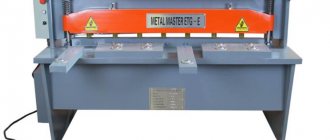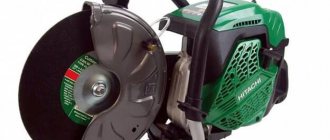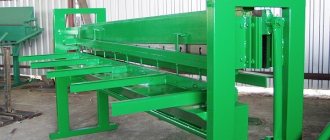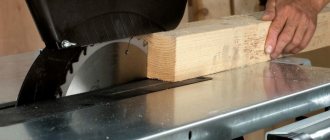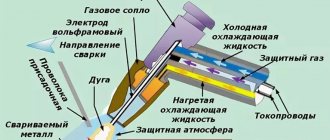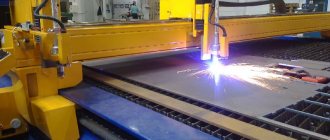Cutting metal with hand scissors
TO
category:
Metal cutting
Cutting metal with hand scissors
Next: Cutting metal with a hacksaw
Manual musical instruments are used for cutting steel sheets with a thickness of 0.5 - 1.0 mm and non-ferrous metals up to 1.5 mm. Hand scissors are made with straight and curved cutting blades,
According to the location of the cutting edge of the blade, hand scissors are divided into right and left.
Rice. 1. Elements of scissors
Right-handed scissors are those in which the bevel on the cutting part of each half is on the right side. Using right scissors, cut along the left edge of the product in a clockwise direction.
Left-handed scissors are those in which the bevel on the cutting part of each half is located on the left side. These scissors are used to cut along the right edge of the product counterclockwise.
When cutting a sheet with right-handed scissors, a mark is always visible on the metal being cut. When working with left-handed scissors, in order to see the mark, you have to bend the cut metal with your left hand, passing it over your right hand, which is very inconvenient. Therefore, sheet metal is cut in a straight line and along a curve (circle, rounding) without sharp turns with right-handed scissors.
The scissors are held in the right hand, grasping the handles with four fingers and pressing them to the palm; The little finger is placed between the handles of the scissors.
The clenched index, ring and middle fingers unclench, straighten the little finger and, with its effort, move the lower handle of the scissors to the required angle. Holding the sheet with your left hand (Fig. 2, b), feed it between the cutting edges, directing the upper blade exactly in the middle of the marking line, which should be visible when cutting. Then, squeezing the handle with all fingers of the right hand, except the little finger, they cut.
In Fig. 2, c, d shows techniques for working with scissors.
For straight cutting of metal of small thickness, hand scissors are used, one handle of which is clamped in a vice.
Chair staves differ from manual ones in their larger sizes and are used when cutting sheet metal up to 3 mm thick. The lower handle is firmly clamped in a bench vice or fastened (hammered) onto a table or other rigid base. For cutting sheet steel up to 3 mm thick, chair scissors with a stationary fastening are used (Fig. 3, c).
Chair shears are low-productive and require significant effort when working, so they are not used for cutting large batches of sheet metal.
Manual small-sized power music books. Innovator A. N. Vasiliev created small-sized power shears for cutting sheet steel up to 2.5 mm thick, rods, bolts (studs) with a diameter up to 8 mm. The dimensions of these scissors do not exceed the dimensions of standard hand scissors (Fig. 4). For cutting, the handle is secured in a vice, and the handle (working) is activated. The working handle is a system of two levers connected in series. The first lever, on one arm of which the knife is fixed, is connected to the handle with a screw.
Rice. 2. Working with scissors: a - position of the hand on the handle when cutting with scissors, b - with straight blades, c - with curved blades, d - cutting out the internal curved contour
Rice. 3. Scissors: a - chair scissors, fixed in a vice, b - hand scissors, fixed in a vice, c - chair scissors on a wooden base
Rice. 4. Small-sized power shears
Rice. 5. Lever shears
Rice. 6. Flying scissors
The second arm of the lever, which is the handle of ordinary scissors, is shortened and ends with a hinge, or the scissors handle itself. The end hinge of the handle is connected to the handle using a double-hinged link. This lever system approximately doubles the cutting force compared to conventional scissors of the same size. The scissor blades are replaceable and attached to the levers with hidden rivets.
These scissors also have a device for cutting rods with a diameter of up to 8 mm. The device has discs with holes mounted on scissor arms and is a regular scissors, but with specially shaped knives (hardened bushings). These knives are replaceable and are inserted into the disk socket. For cutting bolts (piles). in the bushings of one of the disks there is a groove (several threads), which protects the threads of the bolts from being crushed during cutting.
Small-sized power shears provide good cutting quality.
Lever shears (Fig. 5) are used for cutting sheet steel up to 4 mm thick, aluminum and brass up to 6 mm. The upper hinged knife is driven by a lever. The lower knife is stationary.
The knives are made from U8 steel and hardened to a hardness of HR.C 52 - 60. The sharpening angles of the cutting edges are 75 - 85°.
Before work, check whether the rubbing parts are lubricated, whether the lever moves smoothly, and whether there is a gap between the cutting edges.
When cutting metal, grab the handle of the lever with your right hand and smoothly move it to the upper position, while the upper knife 3 moves upward. Then the sheet is laid so that the left hand holds it in a horizontal position, and the cut line is in the field of view and coincides with the blade of the upper knife. By moving the hand, lower the lever with the knife down until part of the metal is cut through, after which the lever is moved to the upper position. Next, slightly lift sheet 4 with your left hand, move it along the line along the cutting edge of the upper knife and repeat the cutting technique until it is completely cut. The scissors provide a cut without dents, cuts along the edge and sufficient accuracy.
Fly shears are widely used for cutting sheet metal with a thickness of 1.5 - 2.5 mm with a tensile strength of 450 - 500 MPa (45 - 50 kgf/mm2) (steel, duralumin, etc.). These scissors cut metal of considerable length. Lever shears have a cast iron frame and table. A lower stationary knife is built into the table, and an upper movable knife with a curved cutting edge is fixed in a knife holder. The upper movable knife has a counterweight that balances the knife holder with the knife.
The size of the workpieces to be cut is pre-marked or limited by an adjustable stop, for which the stop is first set at the required distance from the cutting edge of the lower stationary knife. During cutting, the sheet is tightly pressed with its side edge against the stop, and with the other edge against the spring stop. After this, by turning the handle away from you, the sheet is pressed tightly from above with a clamping bar and, lowering the upper nose with knife holder 6, the workpiece is cut.
When lowered, the knife holder rests against a spring stop. Rearrangement of the stop is carried out using the handle.
Shears with inclined knives (guillotine) allow you to cut sheet metal up to 32 mm thick, sheets with dimensions of 1000 - 3200 mm, less often strip products, as well as sheet non-metallic materials.
General classification
Modern tools for cutting steel, iron, and other metals cope with material of any thickness. This is due to the variety of shapes and types of products, divided into several groups according to characteristics, including:
- cutting principle;
- principle of operation.
According to the cutting principle, metal scissors are:
- knife;
- die-cutting (notching).
Based on the principle of operation, they are distinguished:
- manual (mechanical);
- electric scissors.
Cutlery is a “classic of the genre.” They have two single-edged knives and cut metal only from the edge of the sheet. Nibblers work on the principle of hollowing out material and are more often used for profiled or corrugated sheets. With their help, metal is cut from the middle of the workpiece.
Knifes are divided into several groups:
- in the cutting direction (left/right);
- according to the shape of the cut (straight/curved).
Products with a right-hand cut have a marking line to the right of the cutting edge; scissors with a left-handed cut are the opposite. Cutting metal with scissors is carried out according to the applied markings, with the upper blade located above it. Straight metal scissors cut the workpiece strictly in a straight line, while curly ones allow you to maneuver and obtain products of unusual shapes.
Metal nibblers
Now let's take a closer look at hand scissors for cutting metal. They are more common than others, and the classification is supplemented by several subspecies.
Electric scissors for fast and precise cutting of sheet material
Accuracy and accuracy of cutting with hand scissors is ensured only by choosing the right tool. In addition to manual scissors, manufacturers also produce electric scissors. The power tool does not require any physical effort to cut sheet material, since the electric motor is responsible for this action. There are two types of electric metal shears:
- Punching or die-cutting - structurally they have no resemblance to manual ones
- Knife - similar to hand tools, and their work is ensured by the mobility of one blade
Die-cut
received this name due to their operating principle. They are used for cutting sheets of corrugated sheets and metal tiles. The advantage of such devices is their ease of use and operational efficiency. When cutting through a steel sheet, sparks do not occur, and the roof covering does not deform. That is why it is recommended to abandon the use of an angle grinder when cutting thin-sheet material, replacing it with manual or electric scissors, or even better, buy an attachment for a drill for cutting metal.
Electric cutting scissors can not only cut straight, but also cut out various curly patterns. If you plan to cut a shape in the center of the sheet, then first you need to drill a hole and then install the cutting edge of the scissors into it. They work on the principle of a hole punch, and a movable mechanism—a punch—is responsible for punching through steel. When piercing steel, the knife moves very quickly, so the possibility of deformation and bending of the sheet is excluded.
In addition to cutting (or mortise) scissors, there are also knife scissors
. They are also called sheet or spline. They are very similar to manual ones, only they consist of movable and stationary knives. The movable blade moves due to an electric drive, making reciprocating movements. They are suitable not only for making straight cuts, but also for curved ones.
During operation, such scissors do not create waste, but they have a drawback - they jam the corrugated sheets. It is recommended to use them exclusively for cutting smooth sheet materials such as galvanized sheets, tin, etc. During operation, only the movable cutting knife becomes dull, which must be sharpened and replaced when worn.
Types of hand scissors for metal
The task of the tools in question is to cut workpieces using human physical strength. The group includes:
- ordinary;
- lever;
- roofing (chair);
- hydraulic;
- disk (roller);
- sheet metal scissors.
VIEW Sheet metal cutting shears on AliExpress →
Chair scissors
Lever metal shears
In conventional models, the cutting edge and handle are made of the same material by forging. The efficiency of the tool is affected by the applied force, the length of the cutting edge, and the length of the handle. Conventional hand metal shears are divided into:
- pass-through (straight cut);
- curly (curvilinear);
- ideal (universal; cuts both straight and curved).
Lever metal shears differ from the above mentioned ones in that they have a hinged connection between the cutting edge and the handle. This creates an additional lever that facilitates the work of the master. The required force to cut the workpiece is less, and the quality of work does not suffer. They have one drawback - they don’t work without being attached to a workbench.
For materials of medium thickness (2-4 mm), roofing devices are used. The design allows them to be attached to a mechanic’s workbench so that the master spends less physical effort. The name indicates the compatibility of the tool for cutting profiled sheets (used for roofing) and similar products of complex shape.
It is important to know that among manual devices there are no die-cut ones. The remaining types of scissors have a complex design and therefore require separate consideration.
Why do you need guillotine shears?
There is another type of scissors, which also belongs to the group of hand tools. They're called
guillotine, which consist of a frame, as well as a fixed knife and a movable blade. Due to their design, they are also called tabletop or stationary. To cut sheet material, it is necessary to place the sheet on the knife according to preliminary markings. The sheet is cut by lowering the cutting blade.
This type of tool is suitable exclusively for cutting in a straight direction. They are not suitable for circular cutting, so you should choose a tool depending on its purpose. Guillotine shears are used in industry when large volumes of work are performed. Manufacturers also produce hydraulic guillotine tools for cutting pipes, profiles and other compact non-sheet materials.
Features of hydraulic products
The products are designed for cutting metal structures (rods, profiled iron, scrap, fittings) using an evenly distributed force along the length of the blade. Conventionally divided into two groups:
- small-sized;
- large-sized.
Hydraulic shears are actively used by rescue services
The first ones are also called manual. For example, the following are manual hydraulic shears NGR-20 “KVT”. Their purpose is to cut armored cables, fittings, and steel ropes. The main characteristics include:
- permissible thickness of the cut product is 20 mm;
- high-strength cutting blade (60-62 on the Rockwell scale);
- maximum force - 5 t;
- length - 36 cm, weight - 3.2 kg;
- the presence of a rotating guillotine type head;
- addition of a pressure release lever to the design;
- cost about 20 thousand rubles.
VIEW Hydraulic Shears on AliExpress → Large tools are bolted onto the base machine. Intended for:
- scrap metal cutting;
- recycling of cars, buses, trucks;
- dismantling of metal structures;
- cutting and recycling of rolling stock;
- cutting of boats, ships, boats.
Impressive hydraulic shears for cutting metal are available in several series. For example, AD class models dismantle steel structures, MP-T is suitable for longitudinal cutting of metal (sheet), DS for reinforced concrete, and so on.
Operating rules
To extend the service life of the tool, it is important to follow the basic operating rules:
- the tool and cutting part must be kept clean;
- oil changes are carried out at least once every six months;
- Before storage, scissors should be cleaned and lubricated with an anti-corrosion compound;
- during operation, the thickness of the metal being cut should not exceed the standards stated by the manufacturer.
Possible faults
The main malfunctions of hydraulic tools for metal are:
- the rod does not return to the neutral position - the return spring must be replaced;
- no or insufficient oil pressure - requires changing the oil, closing the lever to relieve excess pressure or cleaning the hydraulic drive;
- There are oil smudges on the outside - the seals need to be replaced.
To avoid various breakdowns, you must follow the operating rules of the tool described in the technical data sheet. Before use, the tool must be checked for defects.
Disc tool features
Disc shears, also known as roller shears, are a more advanced design. The working bodies are roller knives, which, when rotated in different directions, are pressed into the workpiece and cut it. Mutual friction between the metal and the disks causes the sheet to move along the tool.
Roller metal shears
Typically, disc shears have two rollers - top and bottom. Their relative arrangement is of three types:
- parallel;
- with one inclined roller;
- with both inclined rollers.
Manual circular shears with a parallel position of the working parts are used for cutting metal into strips. The second group is used when working with ring or round workpieces. The third is for them, but with a small radius.
The distinctive properties of the tool are its speed of operation and the absence of the need for additional processing of the cut edge. In addition, roller shears for cutting sheet metal cost in an acceptable range from 20 to 40 thousand rubles, thanks to which they have become very popular among consumers.
Purpose and principle of operation
The soldering iron is used both in repair and installation operations.
The classic electrical version is used to melt tin and apply it to the seats of printed circuit boards, which allows radio components to be fixed to them.
In other words, this hand tool is used to heat flux and parts during soldering and tinning, to add solder to the contact points of parts to be soldered together.
The working principle of a soldering iron is to convert electrical energy into thermal energy and then transfer the heat to the solder to melt it.
When frozen, the latter connects the parts or their elements to each other.
As a heating device, the tool is sometimes used to melt plastic, remove and apply hot-melt adhesive, if a special hot-melt gun is not at hand.
Features of Sheet Shears
The operating principle is reminiscent of conventional household analogues.
A static knife is mounted on a rigid support, and a movable knife is mounted on a perpendicular plane. The support zone is adjustable, allowing the user to select the desired gap between both blades to suit the thickness of the workpiece. Sheet metal shears cut the workpiece only from the edge; from the middle the design will not allow. Shaped cutting is also difficult to achieve.
The demand for products is due to the correct ratio of the thickness of the sheet being cut and the cost. For example, sheet metal shears Makita BJS160Z cost about 10 thousand rubles, and have the following characteristics:
- maximum cutting thickness for steel - 1.6 mm, aluminum - 2.5 mm;
- minimum cutting diameter - 0.5 m;
- battery power;
- stroke frequency - 4300/min.
This tool is sufficient for standard home and garage work.
Domestic manufacturers offer products with similar parameters and lower prices. For example, sheet metal shears Caliber-Master ENN-500 with a maximum cutting thickness of 2.5 mm will cost the consumer 4 thousand rubles. However, user reviews indicate that foreign manufacturers (Makita, Bosch, Metabo and others) supply more reliable equipment to the market.
VIEW Makita Sheet Shears on AliExpress →
Independent production of products
Since cutting metal with hand shears is so easy, some craftsmen don't see the point in buying expensive equipment. This is especially true for roller models - expensive and attractive. However, it is not difficult to make homemade metal scissors if the material of the knives is a durable alloy, the strength of which is higher than that of the material being cut.
It is common to use bearings as rollers. Their ends are pre-sharpened. The drive roller is fixed to the handle, with pressure on which the tool is pressed into the workpiece. Next, the user only pulls the sheet of metal towards himself, keeping the handle pressed to the base.
No matter how easy it may seem to make metal scissors with your own hands, it is not recommended. Equipment from well-known brands will ensure safe operation when cutting workpieces and will last longer. In addition, there are models on the shelves that do not require additional units for operation (homemade lever scissors for metal, for example, work only in conjunction with a machine).
Operating principle
Man became familiar with the guillotine many centuries ago. However, in those distant times it was used not as a device for cutting metal, but for executing criminals. Modern varieties of scissors use the same principle of operation as in the very first device, which had one upper knife. To cut metal, a blade is used, which is first raised to a certain height and then sharply lowered.
Mechanical scissors equipped with an electric drive use a slightly different algorithm. Their design includes a feeding device through which a metal sheet is supplied from the unwinder to the table. Next, the workpiece is leveled, focusing on the limiter for selecting the feed depth and the side stop. After this, it is rigidly fixed using a clamping mechanism made in the form of a beam. Thanks to this preparation, conditions are created to ensure sufficiently high cutting accuracy.
When the device starts, the gearbox engine transmits torque to the shaft, which directs its energy to the connecting rods and cranks, causing the crosshead to move back and forth. As a result of the movement of the traverse, the upper knife lowers and makes a cut. The scraps of material formed after cutting enter the tray, towards the operator, forward or backward - it all depends on the design of the scissors. The processed workpieces are sent to the receiver. After this, the traverse rises and takes its original upper position. The sensor immediately reacts to this, the signal from which turns off the gear motor.
The function of controlling the upper and lower position of the scissors cross-arm is assigned to the limit switches. In the upper part it is secured with a brake drum located on the shaft. Metal sheet cutting can be carried out longitudinally or transversely. It all depends on the type and location of the knives. With transverse cutting, the knife makes only one cut per working cycle, and with longitudinal cutting, several such cuts are made, and they are always accompanied by the translational movement of the metal workpiece along the table. The second mode is intended for cutting rolled materials into strips. It is also used to produce blanks from metal sheets longer than 2 m.
The force of gravity forces the sharply sharpened knife of the guillotine shears to move downwards from the top point. At the same time, its movement occurs with significant acceleration, since it has a fairly large weight, but at the same time it is not enough for through cutting through durable metal.
The chopping device cannot destroy the integrity of a metal workpiece solely due to its weight due to the fact that the knife is located at a height with a shorter run-up length than in similar first devices of the last millennium. In order for the cutting device to move at the required speed, a special structure is made for it, into which a knife weighing several tens of kilograms is installed.
These same reasons explain why guillotine shears use a lower fixed knife. Thus, modern guillotine machines operate simultaneously on the principle of both conventional scissors and a guillotine. Before cutting, the prepared material is placed on the work table between the lower and upper cutting blades. But because of this, the machine acquires a more complex design, which affects its cost. However, thanks to this solution, it is possible to ensure higher quality and accuracy of cutting metal sheets.
Tips for choosing
Before purchasing, the consumer studies the characteristics of the tool:
- power;
- battery capacity (when selecting class models);
- ergonomics;
- maximum metal thickness;
- maneuverability;
- protective functions;
- execution of the starting unit;
- functionality of cutting parts.
The user must remember the safety precautions and check the serviceability of all components of the unit before starting work. When using electric shears, give them breaks to allow the motor to cool down.
The above classification of products for cutting metal blanks will help novice craftsmen navigate the variety of existing models.
Exploitation
In order not to injure yourself and to complete the work successfully, you must follow a number of rules for operating power tools or homemade devices. These include:
- Wear strong gloves to protect your hands from chips and cuts from the sharp edges of metal sheets.
- Use protective gloves.
- It is advisable to fix the part motionless with the help of third-party devices so that you can hold and operate the power tool with both hands. This way the cuts will be smooth.
- Clean work surfaces from foreign debris, rust, and plaque.
- Check the integrity of the wire through which the connection to the general network occurs. Do not use twists to repair it.
- Before starting work, check the sharpness of the cutting parts of the scissors. If they become dull or visible defects appear, the moving part must be replaced. You can buy a new element at a hardware store or the manufacturer’s service center.
- You must not attempt to cut workpieces with a tool exceeding the maximum thickness indicated in the technical data sheet.
- It is advisable to buy a new power tool. It comes with a warranty period.
- If the metal is jammed between the cutting parts, you need to unplug the electric shears and try to pull them out manually. If you cannot remove metal shavings, you will need to disassemble the working part for cleaning.
- When cutting a part, you need to hold the scissors perpendicular to the cutting line. Deviation in any direction will lead to the appearance of unevenness, burrs, and chewing.
- Do not try to clear the cutting parts from chips when the wire is plugged in.
You cannot start repairing electric scissors yourself without practical experience. This can completely ruin them. By following the operating rules, you can protect yourself from injuries and defective workpieces.

